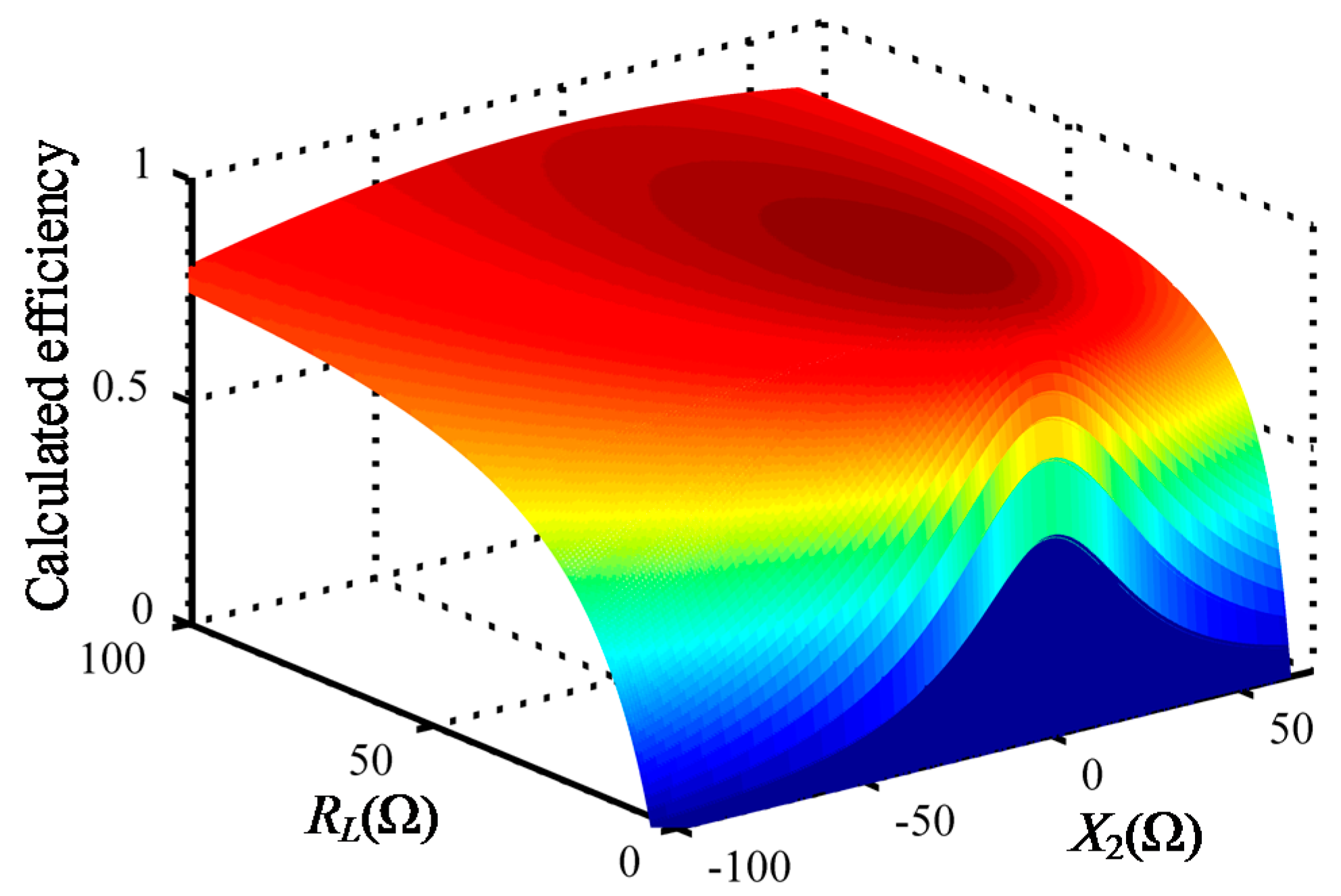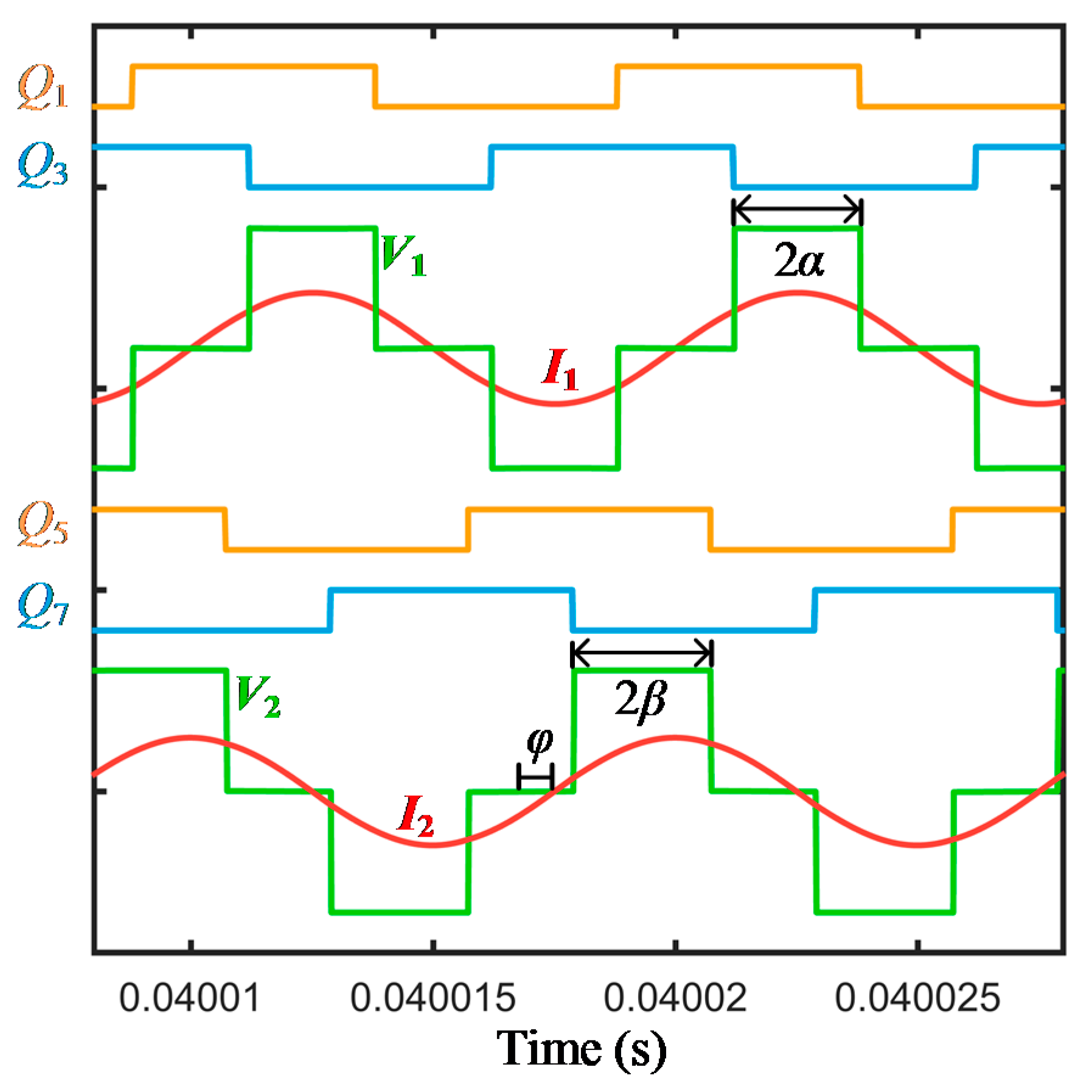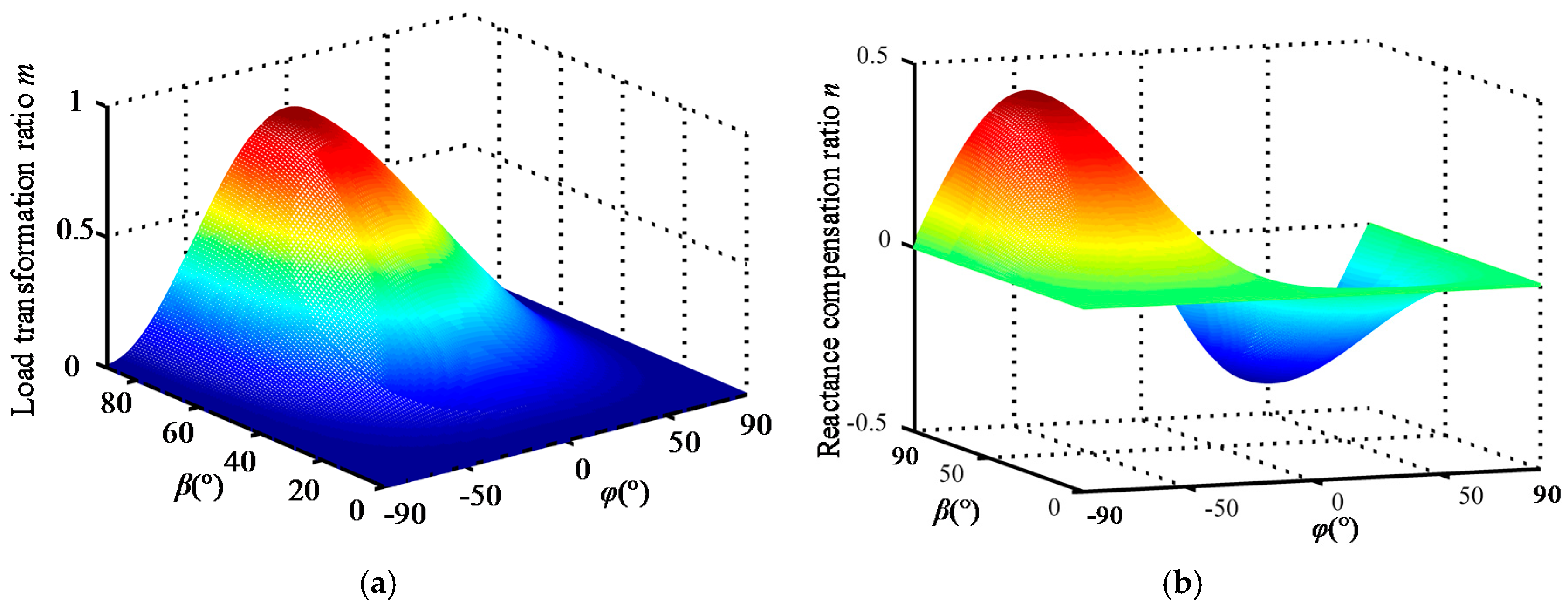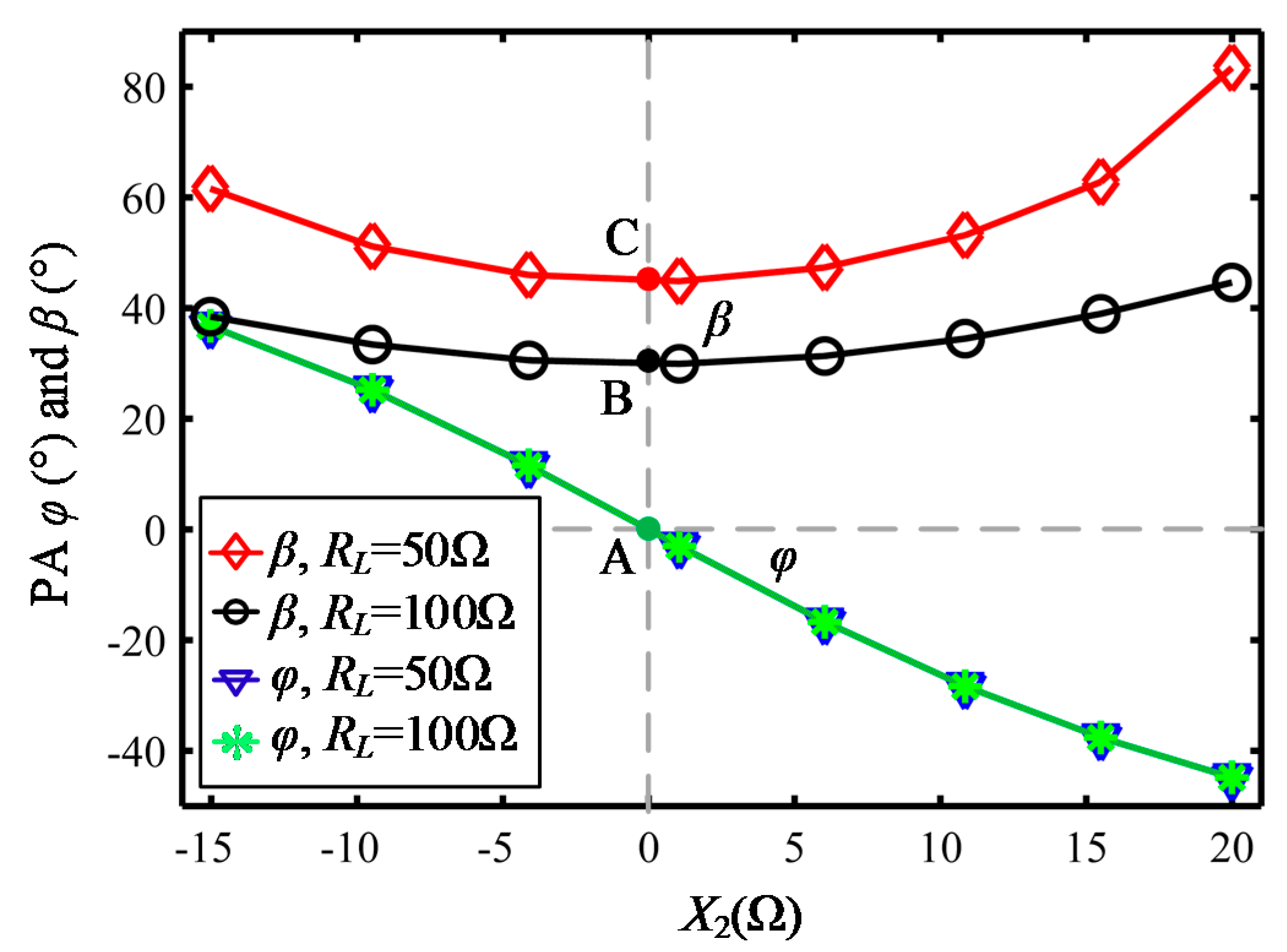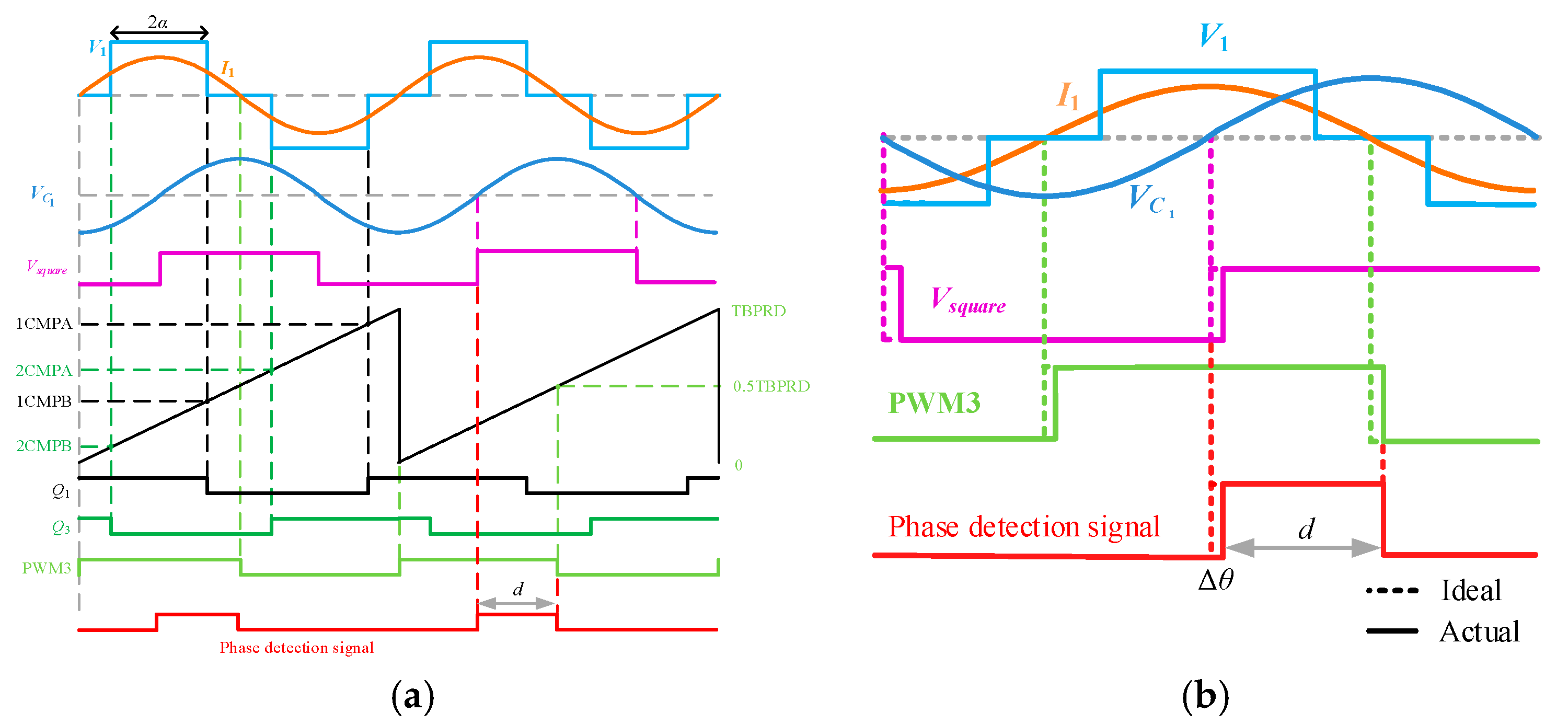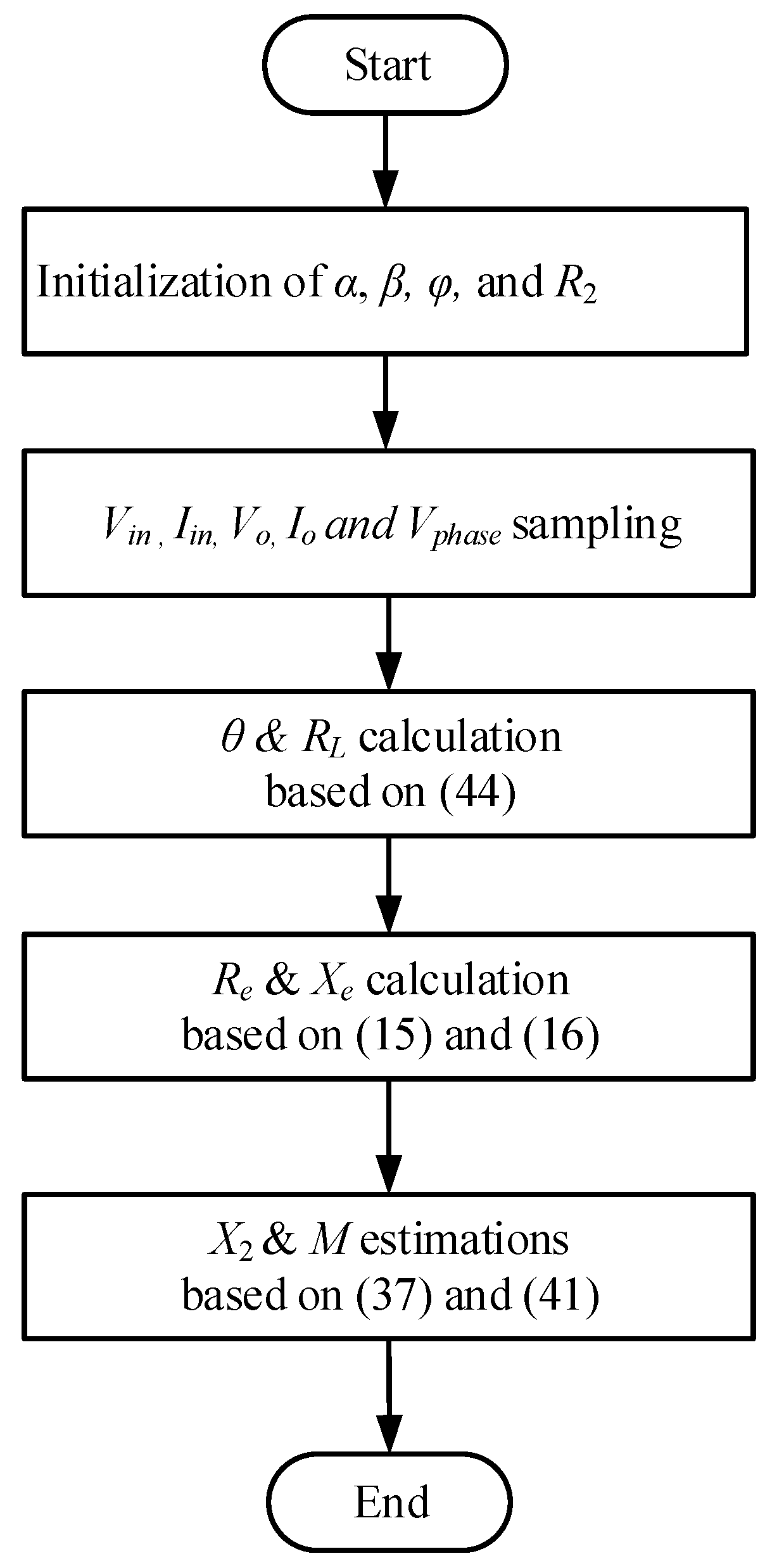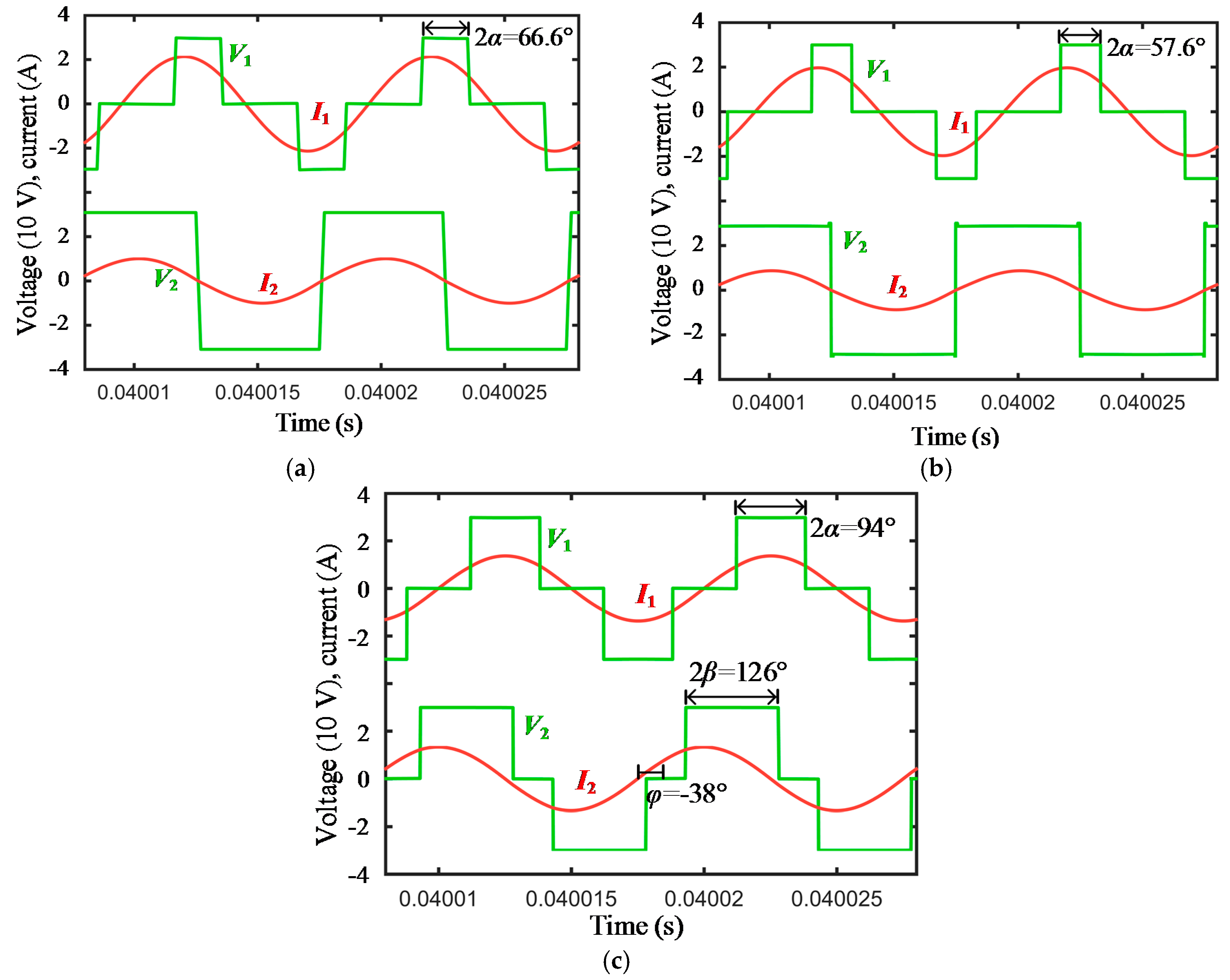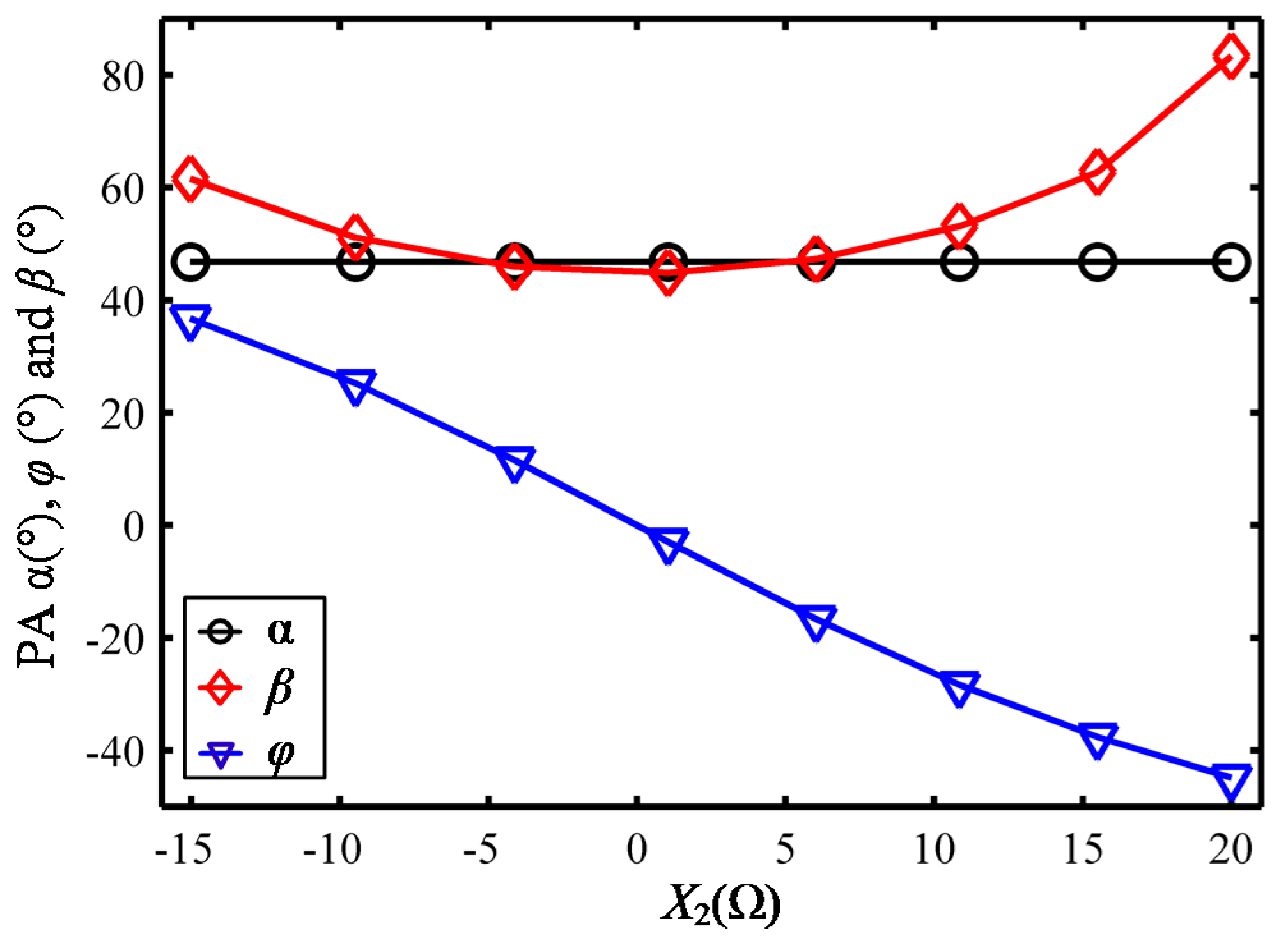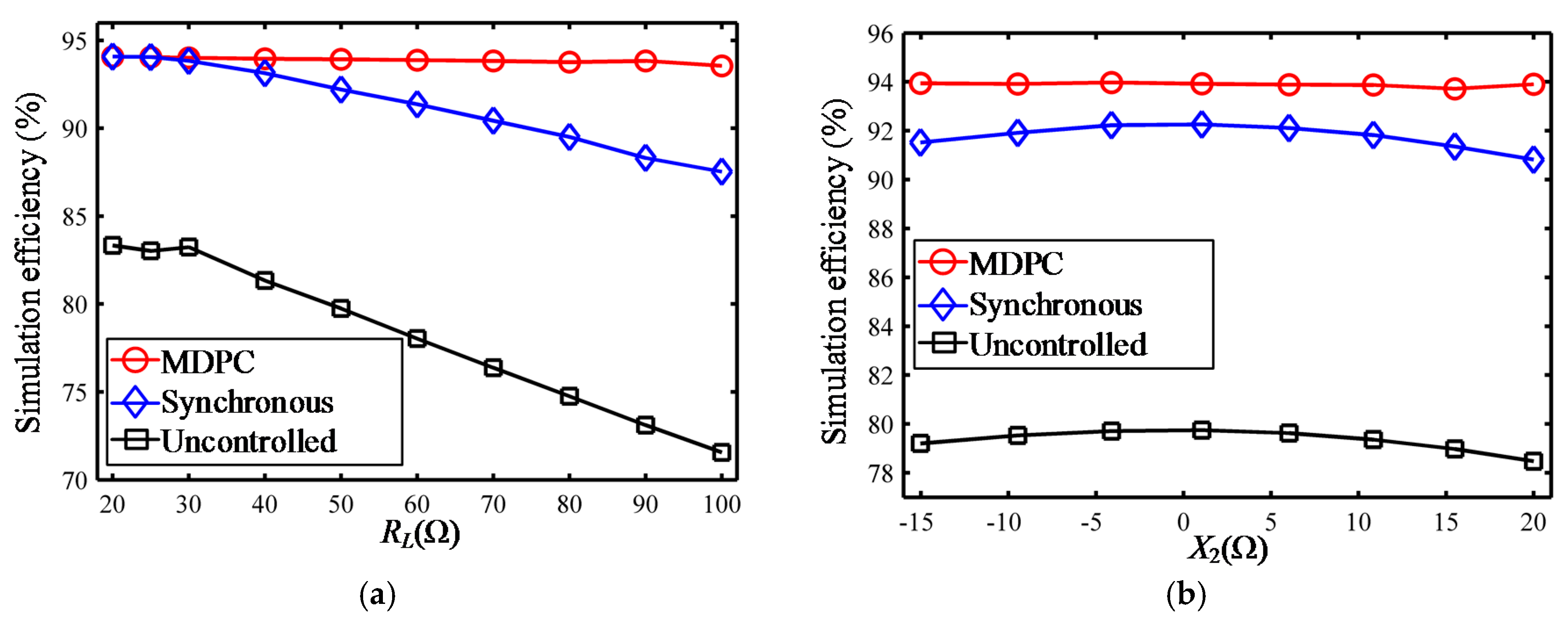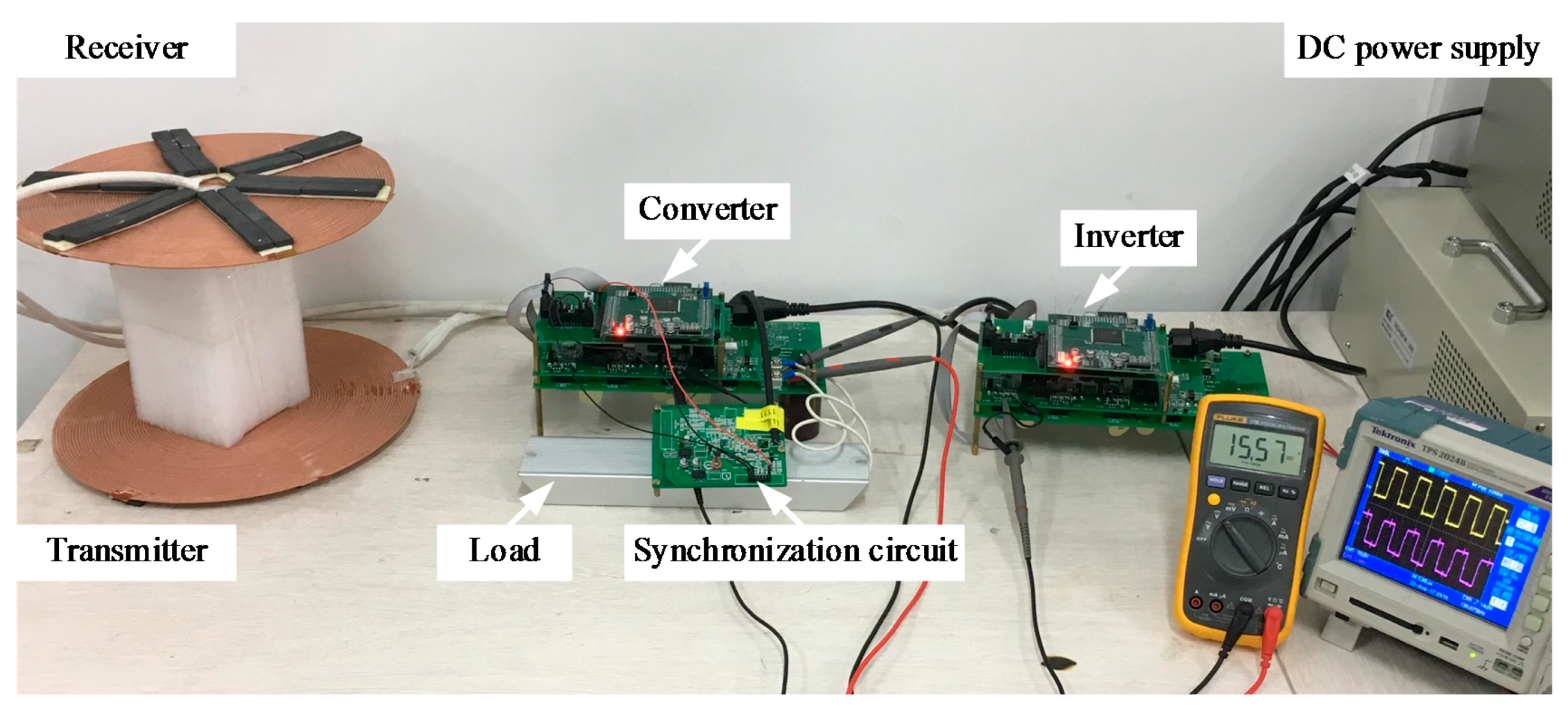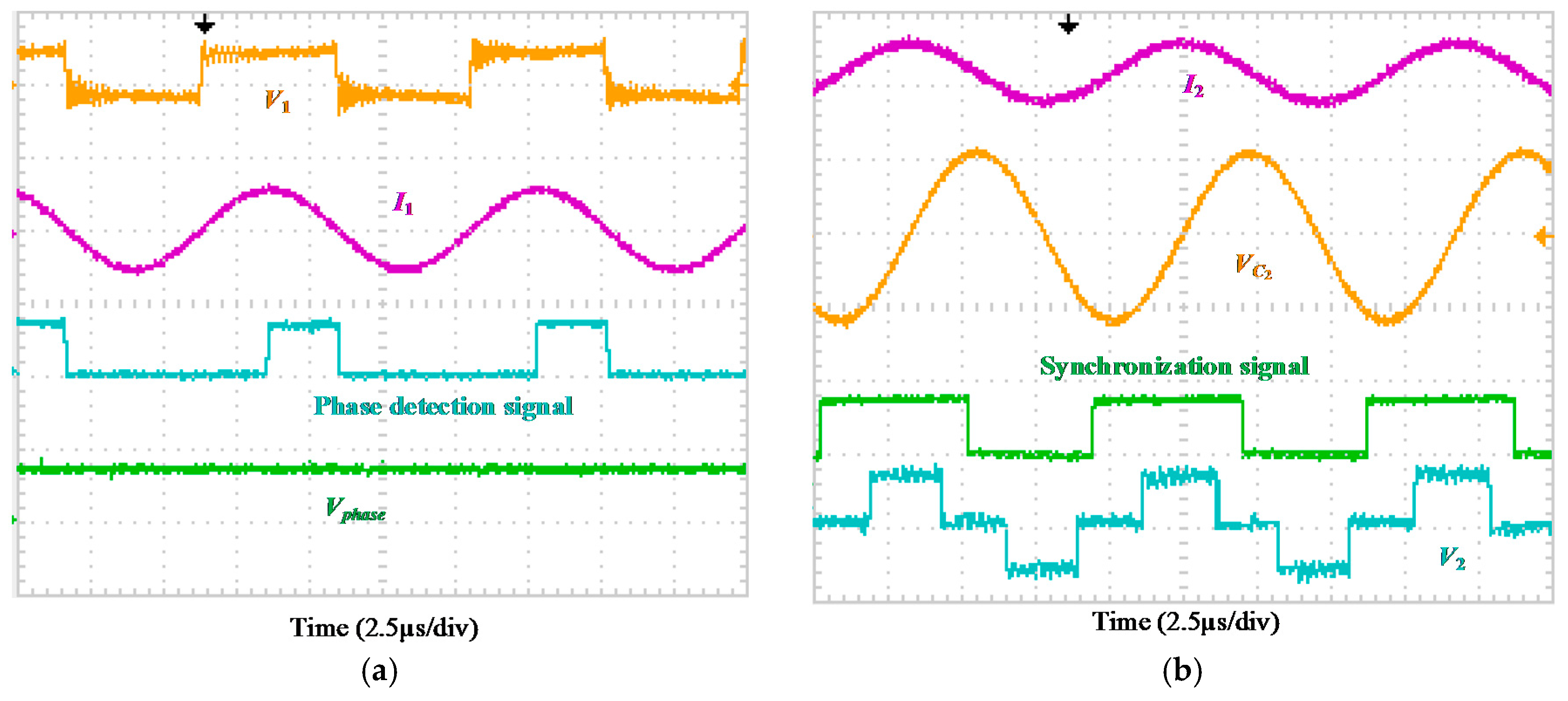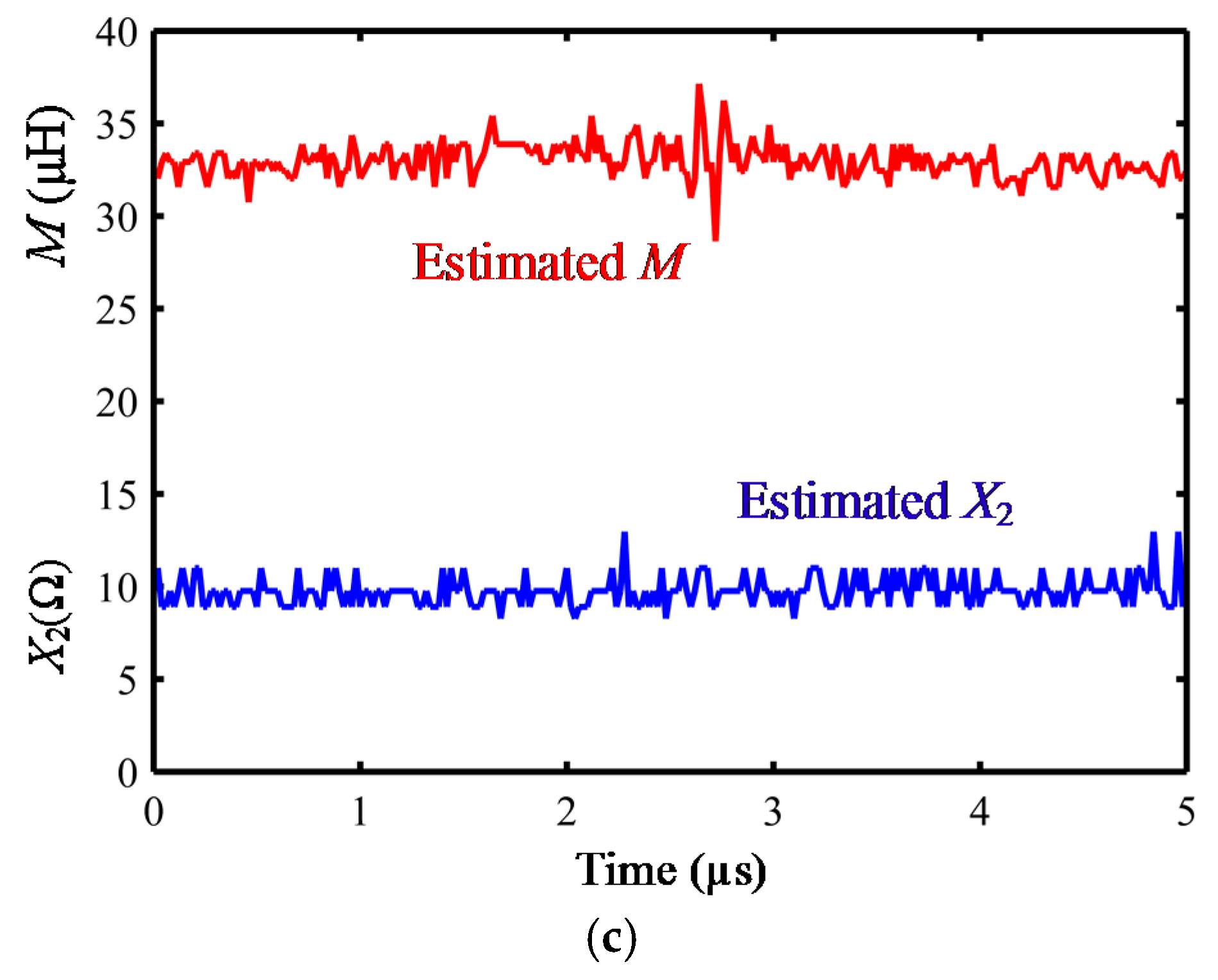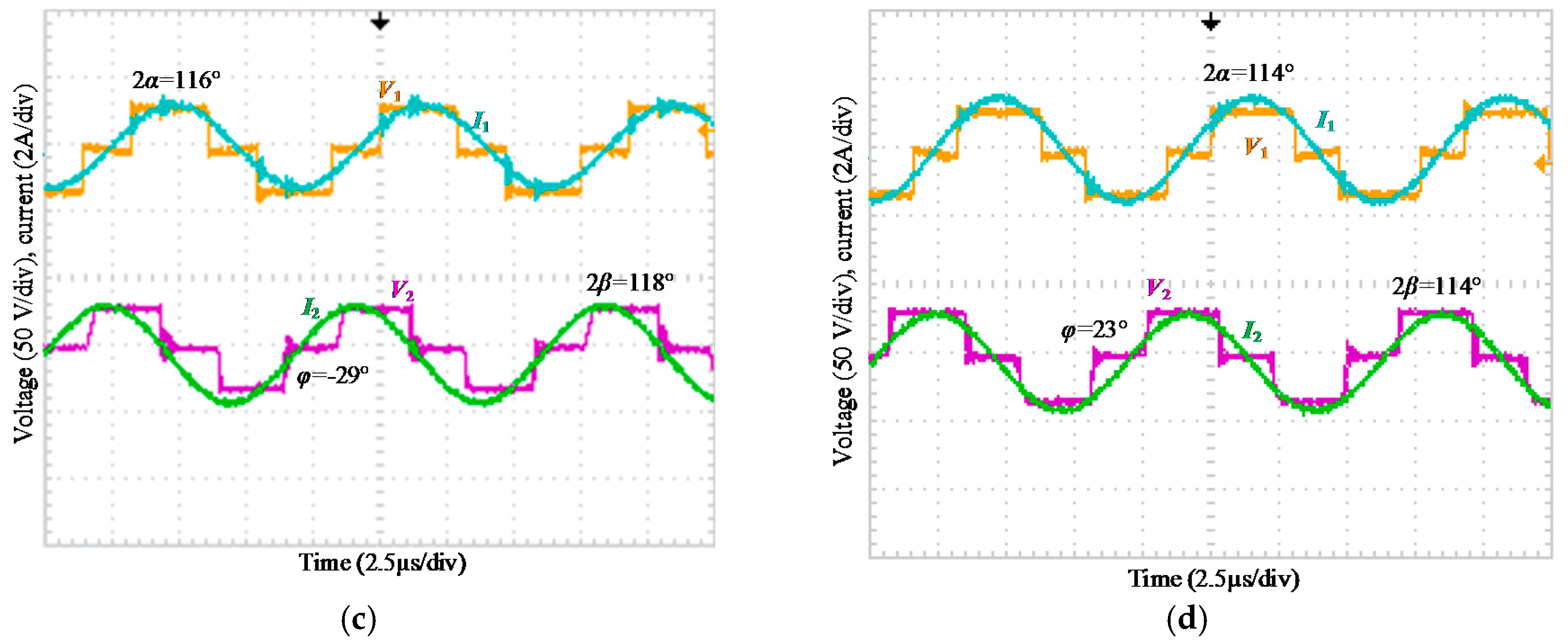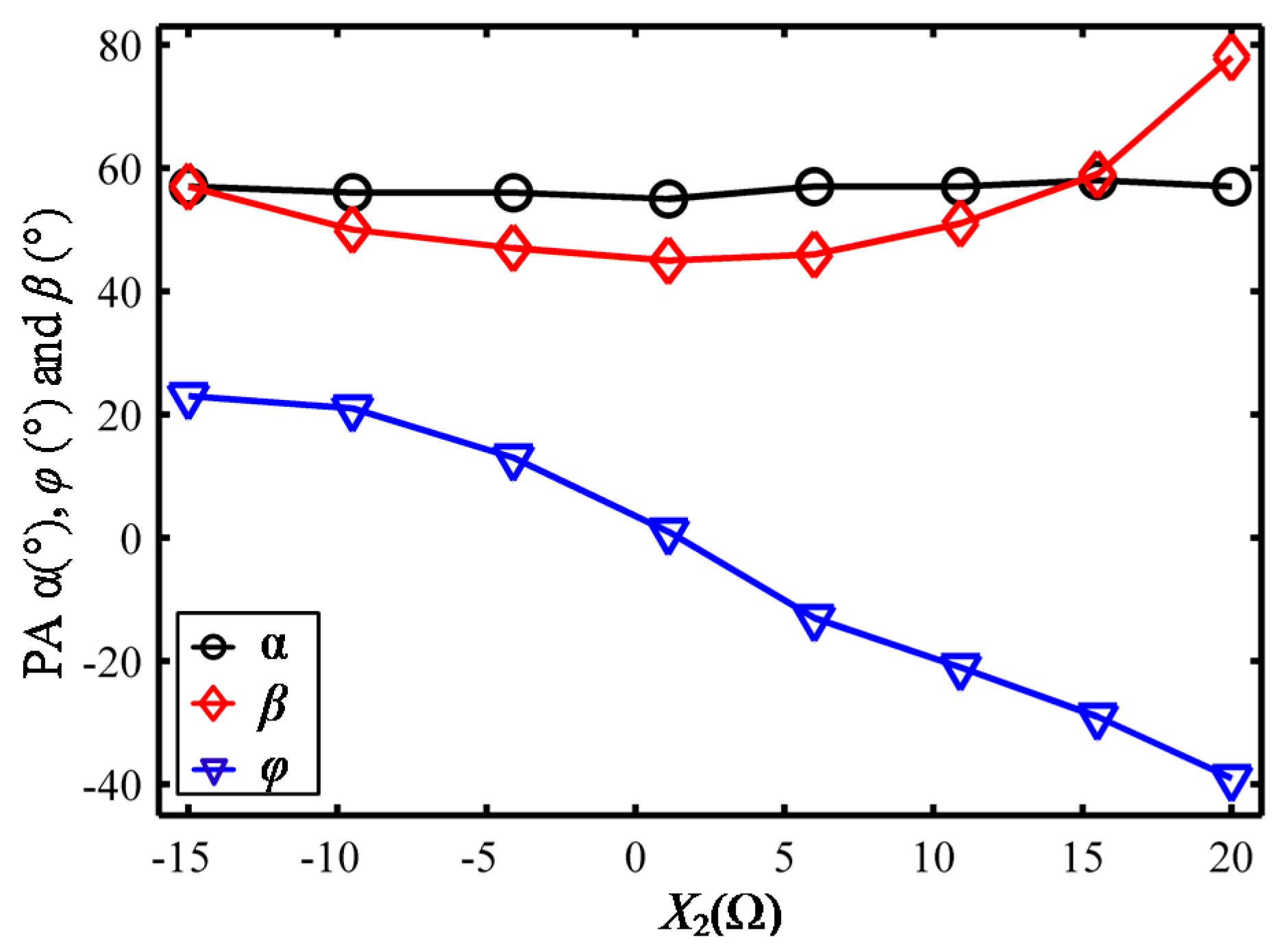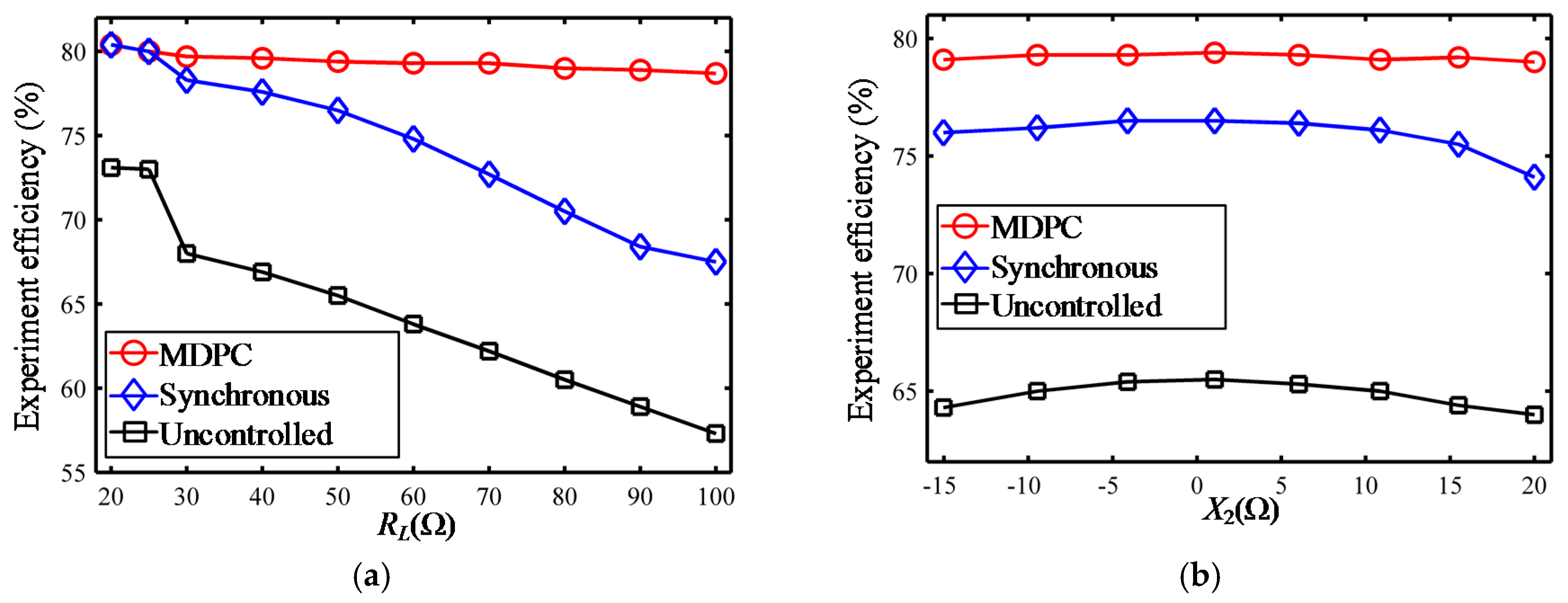1. Introduction
Wireless Power Transfer (WPT) systems can utilize coupling coils to transfer energy through magnetic fields, which can avoid the physical connection of charging lines. Due to their convenience and possibility of widespread applications, the WPT technique has been the research focus of many studies [
1,
2]. Various wireless charging devices have been invented and manufactured for use in applications such as portable consumer electronics and electric vehicles [
3,
4,
5,
6].
Compensation capacitors are indispensable elements of a WPT system [
1]. These capacitors compensate the inductive reactance of the transmitting and receiving coils, and contribute significantly to inducing a meaningful amount of current needed for sufficient magnetic field generation. In order to realize strongly coupled magnetic resonance [
1,
7], the ideal method is to tune the transmitter and receiver at the same resonance frequency. Although capacitor arrays can be used, they require many capacitors, switches and complex control algorithms. Furthermore, high voltage stresses on the resonant capacitors require large packaging and capacitors have large manufacturing tolerances. In addition, the capacitances and the coil inductances vary due to aging. Hence, it is a challenge to select the capacitors with ideal capacitance and rated voltage [
8,
9,
10]. When non-identical resonances occur, the additional reactance increases apparent power and causes additional losses. Thus, extra input power is required at the same load which causes a lower efficiency.
Maximum power transfer efficiency is achieved when the load matches with the system [
7,
11]. In a Series-Series (SS) WPT system, a small loading resistance results in most losses consumed by the receiving coil, whereas a large loading resistance leads to a small reflected resistance and most of the energy is wasted in the transmitting coil. In [
9,
12], a cascaded buck-boost converter is utilized for load transformation. An improved efficiency of 78% with a 16 W transferred power at a distance of 10 cm is achieved in [
12], whereas [
9] realizes an efficiency of 65% when delivering 4.5 W power. In [
13], a two-stage switching converter is applied to modulate the load, an efficiency of 60.2% is obtained for a 20-W load at 20 cm. In [
14], the concept of phase-shift and amplitude control is introduced to modify the equivalent secondary-side load impedance for efficiency enhancement and extractable power optimization. The amplitude control is realized by an additional buck converter on the receiver side. The measured maximum efficiency is 77.3% when the coupling factor is 0.6. In [
15], a front-end boost circuit and a rear-end buck circuit are employed for voltage regulation and load transformation, respectively. The optimal efficiency is 79% when 100 W power is delivered at 20 cm, with 6% power loss measured in DC-DC converters. Compared with traditional systems, these topologies help to transform the load to the optimal value and contribute to improving the efficiency. However, the control of multi-stage system is complex and additional losses in the converters are inevitable. In addition, they can increase the size of the receiver. Greater focus on finding a better solution is needed.
Adding an active rectifier on the receiver side has been proposed in [
14,
16]. Furthermore, researchers have found that Phase Control (PC) can be employed for conduction loss reduction and bidirectional power flow regulation [
17,
18,
19]. In [
16], two Phase Angles (PAs) are applied to regulate dual-side resonant currents equally to reduce losses. However, the de-tuning of the WPT system is not taken into consideration and parasitic resistances are omitted in the analysis. Researchers in [
14,
20,
21] realized that PC can change the effective voltage applied on the resonant tank and the resulting equivalent impedance seen from the AC side. In [
14], the equivalent impedance is regarded as an optimization function and the mathematical expression of the equivalent impedance is not presented. In [
20], a semi-bridgeless active rectifier is investigated and the output power can be regulated by secondary PC. In addition, the equivalent impedance of the semi-bridgeless active rectifier is derived. Both of [
14] and [
20] majorly focus on the proposal of the concept and its derivation, whereas the implementation techniques are not rigorously studied. Researchers in [
21] demonstrate PC from the standpoint of load transformation and additional reactance compensation that achieves a maximum efficiency rise of 10% compared with traditional diode rectifier. An Auxiliary Measurement Coil (AMC) along with a decoupling transformer is adopted to detect the additional reactance. The decoupling transformer is used to cancel out the voltage induced by the receiver side current to the measurement circuit. Therefore, two mutual inductances, one between the receiving coil and AMC and the other of the transformer, should be identical. However, mutual inductance is strongly affected by the inductances, the position of the coils and its surroundings. It is difficult to ensure that two mutual inductances have equal values in experiments. Discrepancy of mutual inductances can bring about an estimation error in principle. In addition, the measurement of mutual inductance, which is an important parameter for optimal load calculation, is not presented. Although a real-time mutual inductance estimation method has been proposed in [
22], it assumes that the WPT system is tuned completely. In [
23], mutual inductance estimation is implemented by detecting primary PA. Nevertheless, when the system operates at secondary resonant frequency, a large estimation error appears. Further work on additional reactance and mutual inductance estimations is required.
Synchronization is an important technique in the control of secondary PC. Researchers in [
18] proposed an AMC for synchronization. However, over 20% phase error occurs at 20 kHz when the load or the mutual inductance changes. In [
21], a current sensor is used to capture the secondary resonant current for synchronization at 30 kHz. Since the current measurement and filtering process involve a significant time delay, a phase-shift circuit should be adopted to correct the resulting phase error. In addition, current sensors have band limits, generally lower than 100 kHz. The synchronization may be more difficult with a higher operating frequency. Therefore, improvement of the synchronization technique is necessary.
This paper presents a detailed analysis and design of a WPT system with dual active bridges. Multiple Degrees of Phase Control (MDPC) are adopted. The system has three degrees of control freedom. Primary PA is responsible for voltage regulation, and secondary PAs for load transformation as well as additional reactance compensation. The proposed additional reactance and mutual inductance estimation methods are based on DC voltage and current samplings, which are easy to be implemented. An effective phase detection technique is elaborated where the phase information is modulated onto a DC voltage signal. In addition, a novel synchronization technique involving a comparator and an isolator is proposed that works satisfactorily at a frequency of 100 kHz. It is simpler and cheaper than previous methods and can withstand parameter variations.
2. Modeling of Wireless Power Transfer (WPT) System
The schematic and equivalent circuit of the proposed system are shown in
Figure 1. In this paper, bold italic letters represent the phasors, whereas italic letters symbolize real numbers or Root-Mean-Square (RMS) values of the phasors.
Vin is the input voltage and
Iin is the input current.
Cf is the film capacitor which makes the inverter decoupled and the input current stable.
Q1–
Q8 are the Metal-Oxide-Semiconductor Field-Effect Transistors (MOSFETs) of two active bridges.
L1 and
L2 are the inductances of the transmitting and receiving coils, whose parasitic resistances are
R1 and
R2, respectively.
C1 and
C2 are the compensation capacitors, and
Co is the output filtering capacitor.
RL represents the loading resistance and
Vo is the voltage across it.
Ze is the equivalent impedance, whose real part and imaginary part are denoted as
Re and
Xe, respectively. The primary resonant angular frequency
ω1, the secondary resonant angular frequency
ω2, the primary reactance
X1, and the secondary reactance
X2 are defined as:
Uncontrolled rectification is utilized in most WPT systems [
7,
9,
12,
24]. The analysis presented is based on full load conditions and the output filtering capacitor is supposed to be large enough to maintain a stable output DC voltage. Thus, the equivalent impedance
Ze is purely resistive [
7,
9]:
The system operates at primary resonance frequency (
f =
f1), that is,
X1 = 0. Based on the Kirchhoff voltage law, current loops are drawn as:
The power transfer efficiency
η is defined as:
where Re represents the real part of the phasor.
By combining Equations (3) and (4),
η is derived:
The three dimensional plot of the power transfer efficiency
η as a function of the load
RL and the additional reactance
X2 is shown in
Figure 2. The related parameters are listed in
Table 1. The efficiency increases with the increase of |
X2| at a constant
RL. The existence of additional reactance causes a larger apparent power, resulting in more losses consumed by the parasitic resistances. Thus, the higher |
X2| and the lower
η. By taking partial derivative of
X2, it is deduced that
η reaches the peak when
X2 = 0. However, the efficiency keeps varying with the load. The calculated efficiency is 49.9% when
RL = 998 Ω, which is required for maximum power transfer capability. Whereas, the efficiency is 95.2% when
RL = 24.8 Ω, which is required for maximum power transfer efficiency [
9].
Figure 2 clearly illustrates the importance of additional reactance compensation and load transformation for efficiency enhancement.
The optimal equivalent resistance
ReOPT can be deduced by taking partial derivative of
Re [
7,
9]:
3. Multiple Degrees of Phase Control
Figure 3 shows the square-wave voltages, fundamental voltages and resonant currents of two active bridges used in the SS WPT system. As can be seen from
Figure 3, there are two PAs in each bridge, thus the total PAs of the system are four.
θ is the PA between primary fundamental voltage and
I1.
φ is the PA between the secondary fundamental voltage and
I2.
α and
β are the PAs of the primary and secondary bridge arms, respectively.
φ changes the impedance of the receiver and the corresponding primary reflected load, resulting in the alteration of
θ. Hence, there only exist three independent and controllable PAs, they are:
α,
β and
φ. Voltage regulation, load transformation and additional reactance compensation can be realized simultaneously by full utilization of these three PAs.
3.1. Equivalent Impedance Derivation
The equivalent impedance of the transmitter (
Zin) is:
Thus, θ can be affected by the reflected resistive and reactive components back on the primary side. In other words, there are only three independent and controllable PAs including α, β and φ. When the secondary additional reactance is compensated (X2 + Xe = 0), Zin is resistive even when Xe 0. According to (6), the optimal load depends on the mutual inductance. When M changes due to the offset of the coils, the corresponding optimal PAs vary. This paper aims to reduce the efficiency degradation caused by parameter variations. On-line estimations can be applied to detect these changes, which can adapt to the mutual inductance and load variations.
Some systems operate at
ω2 and regulate the power flow by the PA between the primary and secondary voltage phasors [
17,
25]. It can introduce reactive power into the system and bring about undesired efficiency degradation. The proposed system operates at
ω1 and utilizes
φ to compensate secondary additional reactance
X2. Power regulation and load transformation are realized by regulation of
α and
β, respectively. This strategy reduces the reactive power that would otherwise be present.
To obtain the optimal efficiency point, the additional reactance should be compensated completely and the load should be transformed to the optimal value. Hence, the mathematical expressions of the equivalent reactance and resistance of the receiver should be derived.
Figure 4 shows the simulated waveforms of primary resonant voltage
V1 and resonant current
I1, secondary voltage
V2 and resonant current
I2, the control signals and the corresponding PAs, where
α and
β are determined when the gate drive signals are valid simultaneously. When the upper switches (
Q1 and
Q3 of the primary bridge,
Q5 and
Q7 of the secondary bridge) or the lower switches (
Q2 and
Q4 of the primary bridge,
Q6 and
Q8 of the secondary bridge) are turned on, the DC voltage is disconnected from the system. Thus, the corresponding voltage (
V1 or
V2) is zero. More details about this commutation can be found in [
21]:
Since the voltage drop across
R1 is small, the above equation becomes true. The SS WPT system maintains the output current, i.e.,
I2 remains unchanged despite load variation or secondary PC. Therefore, the control of
V2 is equivalent to that of
φ, which can be realized by shifting
Q5–
Q8 with respect to
I2. The left shift of
Q5–
Q8 brings about a positive
φ, whereas a right shift brings about a negative
φ. The secondary voltage
V2 can be written as (9):
Thus, β and φ can change the effective voltage applied on the resonant tank and regulate the bidirectional power flow. Essentially, β and φ can change the equivalent impedance Ze in the unidirectional WPT system.
The power consumed by the load is:
and the input active power of the converter is:
Neglecting the losses of the switches, the following equation results:
Then,
I2 can be obtained by:
The equivalent impedance of the secondary active bridge can be defined as:
Thus, the equivalent resistance and reactance versus the PAs and the load are derived by substituting Equations (9) and (13) into (14):
When β = 90° and φ = 0°, secondary active bridge acts as a synchronous rectifier, thus Equation (15) can be simplified as (2) and Xe is zero.
3.2. Voltage Regulation
Primary resonant current
I1 is derived as:
According to voltage-divider theorem on the receiver side, the voltage across
Re (
Ve) is deduced:
The RMS value of the primary voltage
V1 is:
Since,
Ve2/
Re =
Vo2/
RL, the desired
α for voltage regulation can be obtained as:
When the reactance
X2 is compensated completely by
Xe, (20) can be simplified as (21):
3.3. Load Transformation and Additional Reactance Compensation
Load transformation and additional reactance compensation can be realized only with the utilization of secondary PAs. According to Equations (15) and (16), the load transformation ratio
m and reactance compensation ratio
n are defined for normalization, respectively:
where
m ranges from 0 to
. It is single-peaked and the peak value is achieved when
β = 90° and
φ = 0°, as shown in
Figure 5a.
n has one peak and one valley that ranges from
to
, as shown in
Figure 5b.
With the proposed rectifier, the efficiency
η is derived as:
As can be seen from (24), the existence of (X2 + Xe)2 decreases the efficiency. Regarding (X2 + Xe) as a variable and taking partial derivative of it, it can be deduced that η reaches the peak when X2 + Xe = 0. By taking partial derivative of Re, the same expression of ReOPT can be obtained.
The optimal equivalent resistances of the proposed system and the uncontrolled rectification system are the same. To meet the requirements of load transformation and reactance compensation, Equations (25) and (26) should be satisfied:
Substituting (15) and (16) into (25) and (26), the following equations are obtained:
When the load and additional reactance fall into the available regulation range, (27) and (28) can be solved. The values of
φ and
β are:
Figure 6 shows the optimal
φ and
β versus
X2 at different loads. Point A represents the case without additional reactance on the receiver side, hence
φ is zero. When cos
φ = 0,
β is a function of
RL. Point B and C are the optimal angles of
β for 100 Ω and 50 Ω, respectively. A higher load corresponds to a smaller
β, whereas
φ is a function of
X2 and
Re_opt, which is independent of
RL. When the load varies, the optimal
φ should remain unchanged, that is, two solid plots of
φ in
Figure 6 are the same. Once the additional reactance
X2 is compensated completely by
Xe, the reflected impedance of the receiver is purely resistive. Thus,
V1 and
I1 should be in phase, as shown in
Figure 4.
3.4. Additional Reactance and Mutual Inductance Estimations
Mutual inductance and additional reactance determine the optimal values of φ and β. Therefore, it is important to measure these parameters. In this part, easy implementation methods of additional reactance and mutual inductance estimations are elaborated.
It is assumed that primary voltage
V1 lags primary current
I1 by
θ, as shown in
Figure 3a. Then, (31) is obtained:
The equation can be decomposed into two parts, they are:
If
V1 and
I1 are in phase, i.e.,
θ = 0, the following equations are derived:
Since
Xe is controlled, the value of
X2 can be obtained by:
The above equations can be used to estimate X2 in an open loop test. To adjust φ meanwhile observe θ by oscilloscope. When θ = 0, it is assumed that X2 is compensated completely and its value can be obtained according to (36).
Regardless of the value of
θ, the following equations are deduced for on-line estimations:
According to (19), the value of
V1 can be obtained by sampling DC voltage
Vin. Thus, the main task of additional reactance estimation is to detect
θ. Since it is difficult to detect high-frequency PA directly, an indirect and simple method will be presented in
Section 4.
By applying the law of conservation of energy, the input power and output power of primary inverter should be equal, that is:
The following equation can be obtained:
Taking (37) and (40) into (38) and neglecting
I1R1, the simplified estimated
M can be derived:

